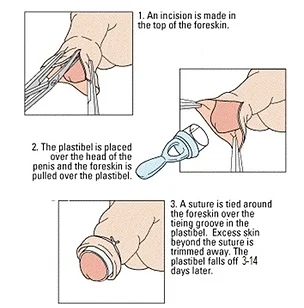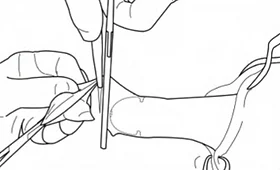Circumcision
The Circumcision Procedure
Circumcision is a minor surgery to remove the foreskin from the tip of the penis (glans). It is an ancient procedure that has been performed for thousands of years.
It is done as a religious obligation for Muslim and Jewish males as well as for cultural reasons (e.g. in certain African countries), and for other reasons such as personal hygiene or medical reasons. At the Circumcision Centre Wales we carry out circumcisions on male babies and infants up to 12 months in age.

Benefits of circumcision
The main medical benefits of circumcision include:
- Improved hygiene of the penis
- Decreased risk of STIs (sexually transmitted infections), including HIV
- Decreased risk of UTIs (urinary tract infections)
- Prevention of penile problems
- Phimosis (inability to retract foreskin)
- Paraphimosis (inability to return an already retracted foreskin back to its original position
- Balanitis (inflamed and sore head of penis)
- Decreased risk of penile cancer
- Decreased risk of cervical cancer in female partners of circumcised men
Circumcision does not affect fertility, nor does it enhance or reduce sexual pleasure for males or their partners.
Circumcision techniques
All circumcisions at our clinic are performed under local anaesthetic so your son should not feel any pain. Depending on the age of your son there are two different techniques that we use which are:
Plastibell (ring) method
This is usually used on babies and infants. First your child will be given local pain relief which usually includes a local anaesthetic injection but may also include topical creams and sprays. Once they have been anaesthetised a small incision is made in the foreskin to allow the Plastibell ring to be inserted around the penile shaft.
The Plastibell device is placed around the glans (head of the penis) and the foreskin is pulled back over the Plastibell ring device and kept in place with a suture (surgical string) that is tied around the foreskin surrounding it. This strangulates the blood supply to the foreskin, causing it to eventually fall off (similar to an umbilical cord), usually between 3 to 14 days after the procedure.

Forceps guided (traditional) method
The forceps method of circumcision is the traditional method and is usually carried out on older children. As with the Plastibell method the first step is for pain relief to be administered by local anaesthetic to the base of the penis. Once fully numb the procedure involves using a special forceps to separate and hold the foreskin away from the glans (head of the penis). The forceps provide a guide for a clean, smooth, cut which is carried out using thermocautery which creates a clean, tidy cut that also has the benefit of minimising bleeding.
The traditional method provides instant results compared to the Plastibell method where you need to wait for the dead skin to fall off naturally. Both methods require keeping the area clean and dry and allowing it to heal naturally.

